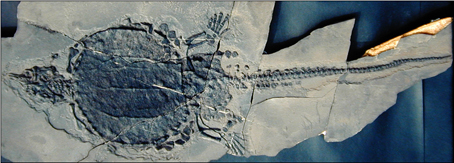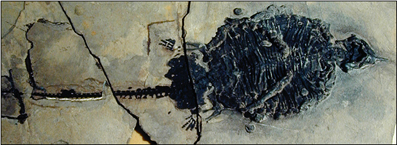
Psephoderma
Etimology: rough skin
Collected Species: Psephoderma alpinum
Systematic Palaeontology: (?)Lepidosauromorpha; Sauropterygia; Placodontia; Cyamodontidae
Distribution: Upper strata of the Calcari di Zorzino (Norian Age)
Locality: Poscante and Endenna (Bergamo, Lombardy, Northern Italy)
Repository: Museo Civico di Storia Naturale, Milano; Museo Civico di Scienze Naturali "Caffi", Bergamo; Museo della Vicaria di S. Lorenzo (Zogno, Bergamo)

Specimen at Museo della Vicaria, 1,8 m long, dorsal view

Specimen at Museo Civico di Scienze Naturali Milano, 1,2 m long, ventral view.
Psephoderma alpinum (Meyer, 1858) is an armoured placodont known from the Late Triassic deposits of Europe since the last century. However, the genus was poorly known until the discovery of more complete specimens in the Norian and Rhaetian beds of Northern Italy. On the basis of these specimens, Pinna established that other Norian-Rhaetian placodont species erected on fragments of the skeleton (Placochelyanus stoppanii, Placochelys malanchinii and Placochelys stoppanii along with Placodus zitteli and probably Macroplacus raeticus and Placochelys alpis-sor-didae) are junior synonyms of Psephoderma alpinum. Psephoderma alpinum is a large reptile, reaching at least 180 cm in total length. Skull is triangular, dorsoventrally flattened; premaxillae is edentulous, very narrow and elongate, forming a sharp rostrum; their posterior portions insert between the anterior parts of the frontals; maxillae is well developed, forming part of the anterior margin of the nasal openings; frontals are narrow, outlining most of the dorsal margin of the orbits; parietal is unpaired with a well developed foramen near its anterior margin; squamosals are flat, large and with a well developed posterior process tapering distally. Quadratojugal is stout, forming most of the lateiril margin of the temporal fenestra. Palatine bones are larger than pterygoids. Mandible is stout, with a large dentary, anteriorly repeating the shape of the premaxillary rostrum, becoming wide posteriorly where two large and flat teeth are present on each ramus of the mandible. Two flat, crushing teeth are present on the maxilla and on the palatine; the posterior palatine tooth is enormously developed. Vertebral column consisting of 5 cervical, 15 dorsal, 3 sacrals and up to 60 caudal vertebrae. Cervical vertebrae are short, with low neural spines and with short zygapophyses and well developed, laterally projecting parapophyses. Caudal centra bear low neural spines and short chevrons. Shoulder girdle little developed, apart from the scapula that shows a stout, vertical scapular blade. Pelvic girdle with a rather high and stout ilium and rounded pubis and ischium. Humerus is stout, with a thick proximal head, and an enlarged, flattened distal one. Femur of about the same length of the humerus; tibia and fibula longer than radius and ulna, forming a well developed spatium interosseum; tarsus consists of rounded astragalus, callcaneum and fourth distal tarsal; first metatarsal is short and broadened, the remaining four straight. Phalanges of the foot are short, the more distal ones rounded and wider than long; phalangeal formula for the pes 2, 3, 3, 3, 2. Carapace is rounded, stout, wide and very flat; sacral region is not covered by armour, and is followed by expanded caudal plate just at the base of the tail. Both carapace and caudal plate consisting of small hexagonal osteoderms probably covered in life by horny scutes. Three longitudinal ridges, made up by keeled osteoderms, are present on the carapace and on the caudal plate. There is no plastron on the ventral surface of the body, but the belly is protected by about 25 stout gastralia.
Click here for further photos
Artwork by S. Renesto unless otherwise indicated. Please do not reproduce/repost/republish etc. any text or image without asking permission to the author
Home Research Triassic Reptiles